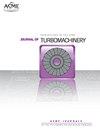DESIGN OF AERODYNAMICALLY BALANCED TRANSONIC COMPRESSOR ROTORS
IF 3.1
3区 工程技术
Q3 ENGINEERING, MECHANICAL
引用次数: 0
Abstract
Abstract This paper describes a simple and efficient physics-based method for designing optimal transonic multistage compressor rotors. The key to this novel method is that the spanwise variation of the parameter which controls the three-dimensional shock structure, the area ratio between the throat and the inlet, ‘Athroat /Ainlet’, is extracted directly from the 3D CFD. The spanwise distribution of the area ratio is then adjusted iteratively to balance the shock structure across the blade span. Because of this, the blade design will be called ‘aerodynamically balanced’. The new design method converges in a few iterations and is physically intuitive because it accounts for the real changes in the 3D area ratio that directly controls the shock structure. Specifically, changes in both the spanwise 3D flow and in the rotor's operating condition; thus aiding designer understanding. To demonstrate this, two example design cases are shown in the paper. A transonic rotor within a multistage civil compressor with variable upstream stator vanes, and an embedded rotor within a multistage military fan. The method is shown to: (1) improve both the operating range and the design efficiency while retaining the compressor's overall matching, and (2) allow a balanced design to be simultaneously achieved at multiple shaft speeds. The result is a method which simplifies the multistage transonic compressor rotor design process and therefore has great practical utility.气动平衡跨声速压气机转子设计
摘要本文介绍了一种简单有效的跨声速多级压气机转子优化设计方法。该方法的关键是直接从三维CFD中提取控制三维激波结构的参数,即喉部与进气道之间的面积比“喉/Ainlet”的展向变化。然后迭代调整面积比的展向分布,以平衡跨叶跨的激波结构。正因为如此,叶片的设计将被称为“空气动力平衡”。新的设计方法在几次迭代中收敛,并且在物理上直观,因为它考虑了直接控制冲击结构的三维面积比的实际变化。具体来说,轴向三维流动和转子运行状态的变化;从而帮助设计师理解。为了说明这一点,文中给出了两个示例设计案例。具有可变上游定子叶片的多级民用压气机内的跨音速转子,以及多级军用风扇内的嵌入式转子。结果表明:(1)在保持压缩机整体匹配的同时,提高了压缩机的工作范围和设计效率;(2)在多个轴速下,可以同时实现平衡设计。该方法简化了多级跨声速压气机转子的设计过程,具有较大的实用价值。
本文章由计算机程序翻译,如有差异,请以英文原文为准。
求助全文
约1分钟内获得全文
求助全文
来源期刊
CiteScore
4.70
自引率
11.80%
发文量
168
审稿时长
9 months
期刊介绍:
The Journal of Turbomachinery publishes archival-quality, peer-reviewed technical papers that advance the state-of-the-art of turbomachinery technology related to gas turbine engines. The broad scope of the subject matter includes the fluid dynamics, heat transfer, and aeromechanics technology associated with the design, analysis, modeling, testing, and performance of turbomachinery. Emphasis is placed on gas-path technologies associated with axial compressors, centrifugal compressors, and turbines.
Topics: Aerodynamic design, analysis, and test of compressor and turbine blading; Compressor stall, surge, and operability issues; Heat transfer phenomena and film cooling design, analysis, and testing in turbines; Aeromechanical instabilities; Computational fluid dynamics (CFD) applied to turbomachinery, boundary layer development, measurement techniques, and cavity and leaking flows.

 求助内容:
求助内容: 应助结果提醒方式:
应助结果提醒方式:


